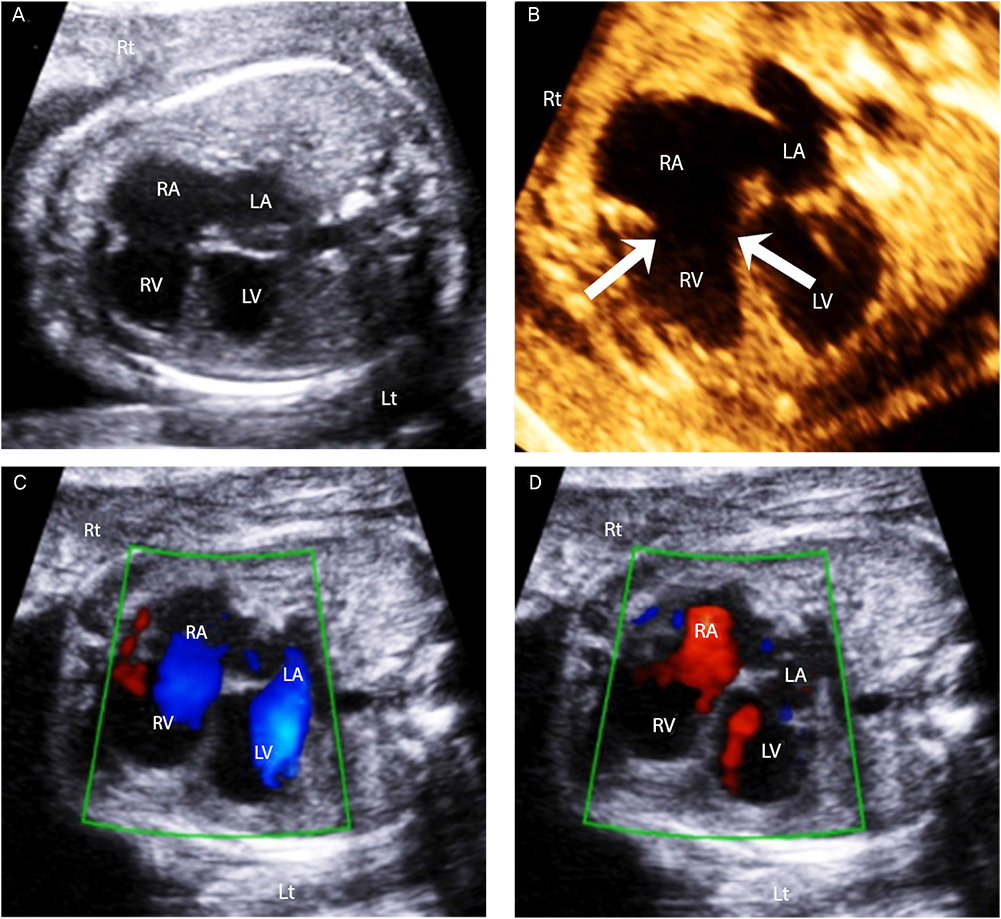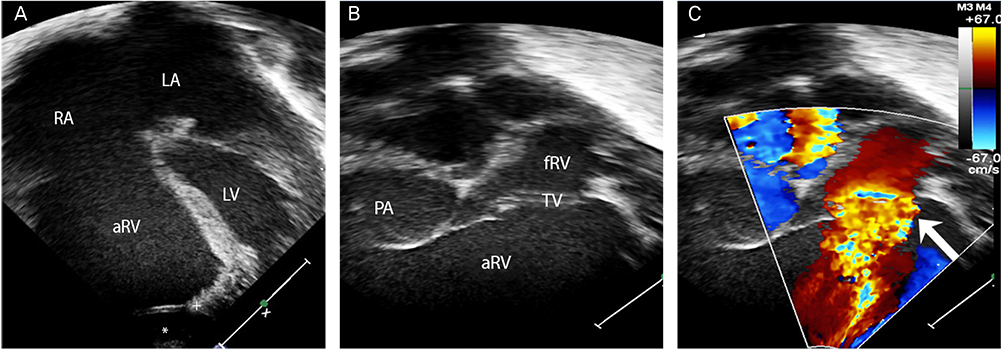Obstet Gynecol Sci.
2014 Nov;57(6):530-533. 10.5468/ogs.2014.57.6.530.
An unusual ultrasonographic manifestation of a fetal Ebstein anomaly
- Affiliations
-
- 1Department of Obstetrics and Gynecology, University of Ulsan College of Medicine, Asan Medical Center, Seoul, Korea. hswon@amc.seoul.kr
- KMID: 2314022
- DOI: http://doi.org/10.5468/ogs.2014.57.6.530
Abstract
- An Ebstein anomaly is a rare congenital heart defect defined by an inferior displacement of the septal and posterior leaflets of the tricuspid valve from the tricuspid annulus. This anomaly shows various ultrasonographic manifestations, thus making the prenatal diagnosis sometimes difficult. We here report a rare case of an Ebstein anomaly which was prenatally suspected as the absence of the tricuspid valve with functional pulmonary atresia because of non-visible tricuspid leaflets on an echocardiograph at 24 weeks of gestation. An emergency cesarean section was performed at 35 weeks of gestation as fetal hydrops were seen on a follow-up scan. Postnatal surgery confirmed Ebstein anomaly type-D which demonstrates an almost complete atrialization of the right ventricle with the exception of a small and infundibular component. Because of its rarity, prenatal findings of a type-D Ebstein anomaly have not been reported previously. We suggest from this first such case report that this anomaly should be considered as a possible diagnosis when the tricuspid leaflets are not well visualized.
MeSH Terms
Figure
Reference
-
1. Dearani JA, Danielson GK. Congenital Heart Surgery Nomenclature and Database Project: Ebstein's anomaly and tricuspid valve disease. Ann Thorac Surg. 2000; 69:S106–S117.2. Attenhofer Jost CH, Connolly HM, Edwards WD, Hayes D, Warnes CA, Danielson GK. Ebstein's anomaly - review of a multifaceted congenital cardiac condition. Swiss Med Wkly. 2005; 135:269–281.3. Paranon S, Acar P. Ebstein's anomaly of the tricuspid valve from fetus to adult: congenital heart disease. Heart. 2008; 94:237–243.4. Melendres G, Ormsby EL, McGahan JP, Moon-Grady AJ, Towner D, Taylor D. Prenatal diagnosis of Ebstein anomaly: a potential pitfall. J Ultrasound Med. 2004; 23:551–555.5. Krieger EV, Valente AM. Diagnosis and management of ebstein anomaly of the tricuspid valve. Curr Treat Options Cardiovasc Med. 2012; 14:594–607.6. Anderson KR, Zuberbuhler JR, Anderson RH, Becker AE, Lie JT. Morphologic spectrum of Ebstein's anomaly of the heart: a review. Mayo Clin Proc. 1979; 54:174–180.7. Yu JJ, Yun TJ, Won HS, Im YM, Lee BS, Kang SY, et al. Outcome of neonates with Ebstein's anomaly in the current era. Pediatr Cardiol. 2013; 34:1590–1596.8. Celermajer DS, Bull C, Till JA, Cullen S, Vassillikos VP, Sullivan ID, et al. Ebstein's anomaly: presentation and outcome from fetus to adult. J Am Coll Cardiol. 1994; 23:170–176.9. Yetman AT, Freedom RM, McCrindle BW. Outcome in cyanotic neonates with Ebstein's anomaly. Am J Cardiol. 1998; 81:749–754.10. Wald RM, Adatia I, Van Arsdell GS, Hornberger LK. Relation of limiting ductal patency to survival in neonatal Ebstein's anomaly. Am J Cardiol. 2005; 96:851–856.11. Carpentier A, Chauvaud S, Mace L, Relland J, Mihaileanu S, Marino JP, et al. A new reconstructive operation for Ebstein's anomaly of the tricuspid valve. J Thorac Cardiovasc Surg. 1988; 96:92–101.12. Chauvaud S. Ebstein's malformation: surgical treatment and results. Thorac Cardiovasc Surg. 2000; 48:220–223.13. Tongsong T, Chanprapaph P, Khunamornpong S, Sirichotiyakul S. Sonographic features of Ebstein anomaly associated with hydrops fetalis: a report of two cases. J Clin Ultrasound. 2005; 33:149–153.14. Davies RR, Pasquali SK, Jacobs ML, Jacobs JJ, Wallace AS, Pizarro C. Current spectrum of surgical procedures performed for Ebstein's malformation: an analysis of the Society of Thoracic Surgeons Congenital Heart Surgery Database. Ann Thorac Surg. 2013; 96:1703–1709.
- Full Text Links
- Actions
-
Cited
- CITED
-
- Close
- Share
- Similar articles
-
- A case of Ebstein's anomaly prenatally diagnosed by fetal sonography
- A case of Ebstein's anomaly prenatally diagnosed by fetal sonography
- Cone Repair in Adult Patients with Ebstein Anomaly
- Cone Reconstruction for Tricuspid Valve Repair in a Patient with Ebstein's Anomaly : A case report
- Surgical treatment of isolated primary tricuspid insufficiency except Ebstein's anomaly: report of 2 cases



